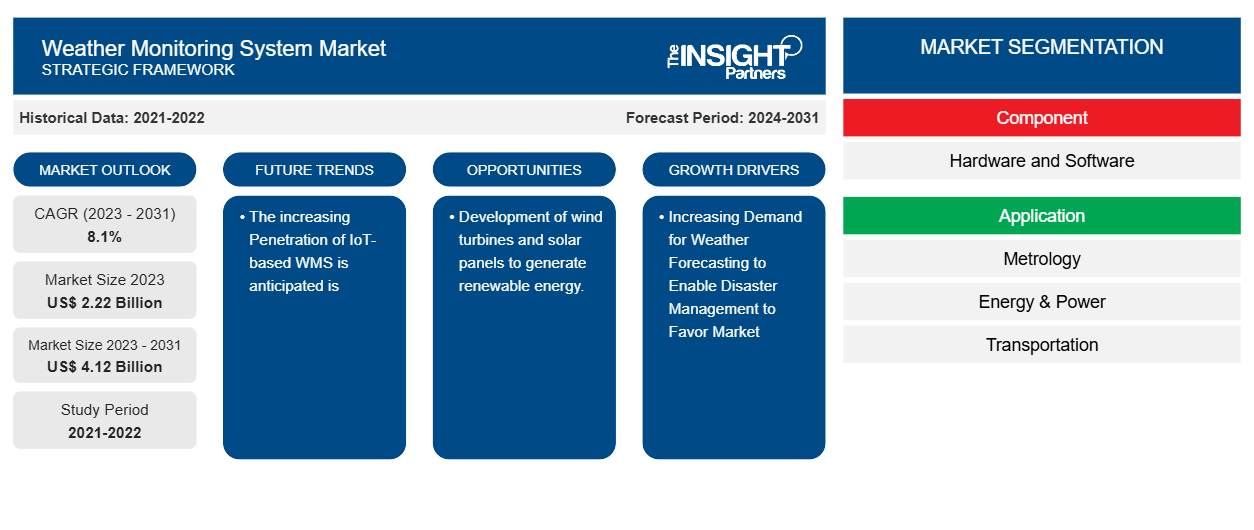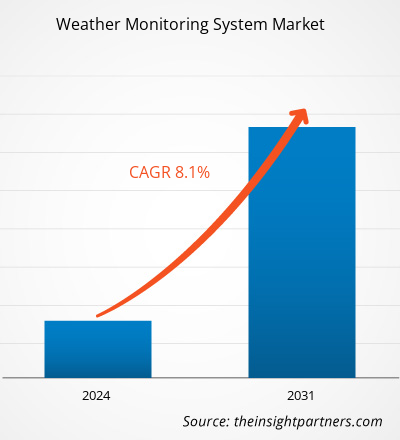The weather monitoring system (WMS) market size is projected to reach US$ 4.12 billion by 2031 from US$ 2.22 billion in 2023. The market is expected to register a CAGR of 8.1% during 2023–2031. The increasing use of weather forecasting to enable disaster management and rising demand for weather forecasting in the aviation industry are likely to be key trends and drivers in the weather monitoring system market.
Weather Monitoring System Market Analysis
The weather monitoring system market is experiencing substantial growth globally. This growth is attributed to the climate-changing pattern leading to uncertainties in the weather and the increasing use of weather forecasting to enable disaster management. Moreover, rise in the production of renewable energy, increasing computing capabilities of supercomputers for weather forecasting and increasing penetration of IoT-based WMS.
Weather Monitoring System Market Overview
The continuous or periodic surveillance or analysis of the state of the climate and atmosphere, including variables such as temperature, moisture, wind velocity and barometric pressure. Further, temperature and humidity sensors are the most frequently used weather sensors. They can be utilized to calculate a heat index, understand whether plants are at risk of damage from too much or figure out if it's safe to work in a given area.
Customize This Report To Suit Your Requirement
You will get customization on any report - free of charge - including parts of this report, or country-level analysis, Excel Data pack, as well as avail great offers and discounts for start-ups & universities
Weather Monitoring System Market: Strategic Insights

-
Get Top Key Market Trends of this report.This FREE sample will include data analysis, ranging from market trends to estimates and forecasts.
Weather Monitoring System Market Drivers and Opportunities
Increasing Demand for Weather Forecasting to Enable Disaster Management to Favor Market
Increasing demand for weather forecasting to enable disaster management is indeed a driver for the weather monitoring system market. Weather monitors/stations serve as critical tools in disaster preparedness and response. By providing accurate and timely weather data, these monitors empower individuals, communities, and authorities to plan, mitigate risks, and efficiently respond to catastrophes. Weather stations act as the bridge between meteorological observations and disaster management, fostering safer and more resilient societies. As technology continues to advance, embracing innovative approaches and integrating new capabilities will strengthen the role of weather stations in the future of disaster management. Thus, considering the above parameters, the increasing use of weather forecasting to enable disaster management is acting as one of the drivers for the weather monitoring system market growth.
Development of wind turbines and solar panels to generate renewable energy.
A WMS is one of the key components in a solar power plant. Its function is to collect data on weather parameters such as module surface temperature, solar radiation, ambient temperature, wind speed etc., at any solar PV site, which assists in monitoring the efficiency and performance of the power plant. The further analysis of this data w.r.t the plant output helps to analyze and improve the performance of the plant. Moreover, for the weather data measurement of the wind power station, the weather station based on SmartSolo data logger is installed on the permanent weather tower to measure the wind speed and direction at two heights, as well as the temperature, relative humidity and air pressure. Thus, owing to the above parameters, the development of wind turbines and solar panels to generate renewable energy is anticipated to hold several opportunities for the weather monitoring system market in the coming years.
Weather Monitoring System Market Report Segmentation Analysis
Key segments that contributed to the derivation of the Weather Monitoring System market analysis are component and application.
- Based on component, the weather monitoring system market is divided into hardware and software. The hardware segment is anticipated to hold a significant market share in the forecast period.
- By application, the market is segmented into metrology, energy & power, transportation, aviation, and others. The metrology segment is anticipated to hold a significant market share in the forecast period.
Weather Monitoring System Market Share Analysis by Geography
The geographic scope of the weather monitoring system market report is mainly divided into five regions: North America, Asia Pacific, Europe, Middle East & Africa, and South & Central America.
North America has dominated the weather monitoring system market. The North America market is segmented into US, Canada, and Mexico. High technology adoption trends in various industries in the North American region have fuelled the growth of the weather monitoring system market. Factors such as increased adoption of digital tools, high technological spending by government agencies and the climate-changing pattern in the region are leading to uncertainties in the weather, and the increasing use of weather forecasting to enable disaster management is expected to drive the North America weather monitoring system market growth. Moreover, a strong emphasis on research and development in the developed economies of the US and Canada is forcing the North American players to bring technologically advanced solutions into the market. In addition, the US has a large number of weather monitoring system market players who have been increasingly focusing on developing innovative solutions. All these factors contribute to the region's growth of the weather monitoring system market.
Weather Monitoring System Market Regional Insights
The regional trends and factors influencing the Weather Monitoring System Market throughout the forecast period have been thoroughly explained by the analysts at The Insight Partners. This section also discusses Weather Monitoring System Market segments and geography across North America, Europe, Asia Pacific, Middle East and Africa, and South and Central America.
Weather Monitoring System Market Report Scope
| Report Attribute | Details |
|---|---|
| Market size in 2023 | US$ 2.22 Billion |
| Market Size by 2031 | US$ 4.12 Billion |
| Global CAGR (2023 - 2031) | 8.1% |
| Historical Data | 2021-2022 |
| Forecast period | 2024-2031 |
| Segments Covered |
By Component
|
| Regions and Countries Covered |
North America
|
| Market leaders and key company profiles |
|
Weather Monitoring System Market Players Density: Understanding Its Impact on Business Dynamics
The Weather Monitoring System Market is growing rapidly, driven by increasing end-user demand due to factors such as evolving consumer preferences, technological advancements, and greater awareness of the product's benefits. As demand rises, businesses are expanding their offerings, innovating to meet consumer needs, and capitalizing on emerging trends, which further fuels market growth.

- Get the Weather Monitoring System Market top key players overview
Weather Monitoring System Market News and Recent Developments
The weather monitoring system market is evaluated by gathering qualitative and quantitative data post primary and secondary research, which includes important corporate publications, association data, and databases. A few of the developments in the weather monitoring system market are listed below:
- A SpaceX Falcon 9 rocket on April 11 launched a U.S. Space Force weather monitoring satellite. (Source: SpaceX Company Website, April 2024)
- The Indian Space Research Organisation (Isro) successfully launched INSAT-3DS, a weather monitoring and disaster warning satellite. The satellite was launched atop the GSLV-F14 rocket from Sriharikota. (Source: ISRO, Press Release, February 2024)
Weather Monitoring System Market Report Coverage and Deliverables
The “Weather Monitoring System Market Size and Forecast (2021–2031)” report provides a detailed analysis of the market covering below areas:
- Weather monitoring system market size and forecast at global, regional, and country levels for all the key market segments covered under the scope.
- Weather monitoring system market trends as well as market dynamics such as drivers, restraints, and key opportunities.
- Detailed PEST/Porter’s Five Forces and SWOT analysis.
- Weather monitoring system market analysis covering key market trends, global and regional framework, major players, regulations, and recent market developments.
- Industry landscape and competition analysis covering market concentration, heat map analysis, prominent players, and recent developments for the weather monitoring system market.
- Detailed company profiles.
Frequently Asked Questions
What is the expected CAGR of the weather monitoring system market?
What would be the estimated value of the weather monitoring system market by 2031?
What are the future trends of the weather monitoring system market?
Which are the leading players operating in the weather monitoring system market?
What are the driving factors impacting the weather monitoring system market?
Which region dominated the weather monitoring system market in 2023?
- Historical Analysis (2 Years), Base Year, Forecast (7 Years) with CAGR
- PEST and SWOT Analysis
- Market Size Value / Volume - Global, Regional, Country
- Industry and Competitive Landscape
- Excel Dataset
Recent Reports
Testimonials
Reason to Buy
- Informed Decision-Making
- Understanding Market Dynamics
- Competitive Analysis
- Identifying Emerging Markets
- Customer Insights
- Market Forecasts
- Risk Mitigation
- Boosting Operational Efficiency
- Strategic Planning
- Investment Justification
- Tracking Industry Innovations
- Aligning with Regulatory Trends





















 Get Free Sample For
Get Free Sample For